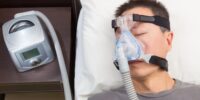Why Should You Monitor Sleep Apnea Progress And Response To Treatment?

Sleep apnea is a common sleep disorder characterized by interruptions in breathing during sleep, leading to poor sleep quality and potential health risks. Monitoring the progress and response to treatment of sleep apnea is crucial for better understanding its impact on health and ensuring effective management.
This article aims to explore the reasons why monitoring sleep apnea progress and response to treatment is vital. By tracking sleep apnea symptoms, individuals can gain insights into the severity of their condition and its impact on daily life. Monitoring treatment progress allows for adjustments in therapy, ensuring optimal results. Additionally, assessing sleep quality and patterns enables individuals to identify potential triggers and make necessary lifestyle changes. Collaborating with healthcare professionals further enhances treatment outcomes.
Regular monitoring of sleep apnea not only helps in managing symptoms but also promotes long-term benefits. It aids in reducing the risk of associated health conditions such as cardiovascular diseases and cognitive impairments. Overall, monitoring sleep apnea progress and response to treatment is essential for individuals to take control of their health and improve their quality of life.
Key Takeaways
- Monitoring sleep apnea progress and response to treatment is crucial for understanding its impact on health and ensuring effective management.
- Regular monitoring allows for early detection of changes or worsening of symptoms, leading to prompt intervention and prevention of complications.
- Tracking treatment progress allows for adjustments in therapy and improves patient outcomes.
- Monitoring sleep apnea helps reduce the risk of associated health conditions such as cardiovascular diseases and cognitive impairments.
Understanding Sleep Apnea and its Impact on Health
Sleep apnea is a serious medical condition that can have detrimental effects on overall health and well-being. It is a disorder characterized by pauses in breathing during sleep, resulting in a decrease in oxygen levels and disrupted sleep patterns. These repetitive episodes of interrupted breathing can lead to a wide range of health problems, including high blood pressure, heart disease, stroke, diabetes, and even premature death.
Additionally, sleep apnea can cause excessive daytime sleepiness, fatigue, and impaired cognitive function, negatively impacting an individual’s quality of life and productivity. Monitoring sleep apnea progress and response to treatment is crucial to ensure that the condition is effectively managed and to identify any necessary adjustments to the treatment plan.
Regular monitoring helps healthcare professionals assess the effectiveness of interventions, improve patient outcomes, and prevent the progression of associated health complications.
The Importance of Monitoring Sleep Apnea Symptoms
Monitoring the symptoms of sleep apnea is essential for assessing the effectiveness of interventions and gauging the progression of the condition. Sleep apnea is a chronic disorder characterized by repeated interruptions in breathing during sleep, leading to fragmented sleep patterns and decreased oxygen levels in the body.
By monitoring symptoms, healthcare professionals can evaluate the response to treatment, such as continuous positive airway pressure (CPAP) therapy, oral appliances, or surgery, and make necessary adjustments to optimize patient outcomes. Monitoring also helps identify any worsening of symptoms or the development of complications, such as cardiovascular disease or cognitive impairments.
Additionally, tracking changes in symptoms over time allows for early detection of any relapse or the need for further intervention. Overall, regular monitoring of sleep apnea symptoms is crucial for optimizing treatment strategies and improving the overall well-being and quality of life of affected individuals.
Tracking Treatment Progress and Effectiveness
By assessing the progression of symptoms, healthcare professionals can effectively track the efficacy of interventions for sleep apnea. Monitoring the progress and response to treatment is crucial in determining the effectiveness of therapies and making necessary adjustments. This allows healthcare providers to optimize treatment plans and improve patient outcomes. Tracking the reduction of symptoms such as snoring, daytime sleepiness, and interruptions in breathing during sleep can provide objective evidence of the success of interventions. It also helps identify any potential issues or side effects that may arise during treatment. Moreover, regularly monitoring sleep apnea progress and treatment response helps patients to stay engaged in their own care and motivates them to continue with the prescribed interventions. Overall, monitoring sleep apnea progress is essential for ensuring the best possible treatment outcomes and improving the quality of life for individuals with this condition.
| Symptoms | Before Treatment | After Treatment |
|---|---|---|
| Snoring | Loud and frequent | Significantly reduced |
| Daytime Sleepiness | Excessive and persistent | Improved, more energy |
| Breathing Interruptions | Frequent and prolonged | Fewer and shorter episodes |
| Quality of Sleep | Poor, restless | Improved, more restful |
| Overall Well-being | Decreased | Increased satisfaction |
Identifying Patterns and Making Adjustments
Identifying patterns in the progression of sleep apnea symptoms allows healthcare professionals to make necessary adjustments to interventions and optimize treatment plans for improved patient outcomes.
By closely monitoring the progress and response to treatment, healthcare providers can identify patterns that may indicate the need for adjustments in the treatment plan. This can include changes in the severity or frequency of symptoms, as well as the effectiveness of interventions such as continuous positive airway pressure (CPAP) therapy or oral appliances.
By recognizing patterns, healthcare professionals can tailor the treatment approach to address specific challenges or issues that may arise during the course of treatment. This proactive approach can lead to more successful outcomes and better overall management of sleep apnea.
Adjustments in treatment plans:
- Modifying the pressure settings on the CPAP machine
- Recommending alternative interventions, such as positional therapy or surgery
Addressing specific challenges:
- Managing mask discomfort or air leaks in CPAP therapy
- Addressing compliance issues through patient education and support
Monitoring Sleep Quality and Sleep Patterns
One crucial aspect of managing sleep apnea involves closely observing sleep quality and patterns to optimize treatment strategies and enhance patient outcomes.
Monitoring sleep quality allows healthcare professionals to assess the effectiveness of treatment interventions and make necessary adjustments. Sleep quality can be evaluated using various objective measures, such as polysomnography, which records brain waves, eye movements, and muscle activity during sleep.
By analyzing these data, healthcare providers can identify any disruptions or abnormalities in sleep patterns that may indicate the presence of sleep apnea or the need for treatment modifications.
Monitoring sleep patterns also helps to track progress over time and evaluate the response to interventions, such as continuous positive airway pressure (CPAP) therapy.
By regularly monitoring sleep quality and patterns, healthcare professionals can ensure that patients receive the most appropriate and effective treatment for sleep apnea.
Assessing the Impact of Lifestyle Changes
Assessing the impact of lifestyle changes allows for a comprehensive evaluation of the effectiveness of interventions on sleep quality and patterns in individuals with sleep apnea.
Lifestyle modifications, such as weight loss, regular exercise, and quitting smoking, have been shown to positively influence sleep apnea symptoms. These changes can lead to weight reduction, which in turn reduces the severity of sleep apnea.
Additionally, regular physical activity improves cardiovascular health and overall well-being, contributing to better sleep quality. Quitting smoking is also beneficial as it reduces airway inflammation and improves respiratory function.
By monitoring the impact of these lifestyle changes on sleep apnea, healthcare professionals can determine the effectiveness of interventions and tailor treatment plans accordingly. This approach ensures a holistic and personalized approach to managing sleep apnea, optimizing outcomes for individuals with this condition.
Collaborating with Healthcare Professionals for Better Results
Collaboration with healthcare professionals enhances the effectiveness of interventions and ensures optimal outcomes for individuals with sleep apnea. Healthcare professionals, including physicians, sleep specialists, and respiratory therapists, possess the expertise and knowledge required to develop personalized treatment plans and monitor the progress of sleep apnea patients.
By working together, patients can receive comprehensive care that addresses their unique needs and preferences. Healthcare professionals play a crucial role in determining the most suitable treatment options, such as continuous positive airway pressure (CPAP) therapy, oral appliances, or surgical interventions. They can also provide ongoing support and guidance, ensuring patients adhere to their treatment plans and make necessary adjustments as needed.
Regular follow-up appointments with healthcare professionals allow for the assessment of treatment efficacy and the identification of any potential complications or side effects. Ultimately, collaboration between patients and healthcare professionals is vital in achieving successful outcomes in sleep apnea management.
Long-term Benefits of Regular Sleep Apnea Monitoring
Monitoring sleep apnea on a regular basis offers significant long-term benefits in terms of optimizing treatment efficacy and improving patient outcomes. Regular monitoring allows healthcare professionals to assess the progress of the condition and the response to treatment, enabling them to make necessary adjustments to therapy and ensure its effectiveness.
Here are four key benefits of regular sleep apnea monitoring:
- Early Detection: Regular monitoring helps identify any changes or worsening of the condition, allowing for prompt intervention and prevention of potential complications.
- Treatment Optimization: Monitoring provides valuable insights into the effectiveness of the current treatment plan, enabling healthcare professionals to make necessary adjustments to optimize therapy and improve patient comfort.
- Compliance Assessment: By monitoring sleep apnea regularly, healthcare professionals can assess patient compliance with recommended treatments, identify any barriers to adherence, and provide appropriate support.
- Long-term Management: Regular monitoring allows for long-term management of sleep apnea, facilitating the prevention of comorbidities and ensuring ongoing patient well-being.
Overall, routine sleep apnea monitoring plays a crucial role in optimizing treatment outcomes and ensuring the long-term health of patients.
Frequently Asked Questions
How can sleep apnea impact a person’s overall health and well-being?
Sleep apnea can negatively impact a person’s overall health and well-being. It is associated with an increased risk of cardiovascular diseases, diabetes, cognitive impairment, and mood disorders. Proper monitoring and treatment are crucial for managing these health risks effectively.
What are some common symptoms of sleep apnea that should be monitored?
Some common symptoms of sleep apnea that should be monitored include loud snoring, daytime sleepiness, morning headaches, difficulty concentrating, and frequent awakenings during the night. Regular monitoring is important in assessing the effectiveness of treatment and managing the condition.
How long does it typically take to see progress and effectiveness from sleep apnea treatment?
The effectiveness of sleep apnea treatment varies depending on individual factors, but improvements can typically be seen within a few weeks to a few months. Regular monitoring is important to assess progress and make necessary adjustments to the treatment plan.
Are there any specific patterns or adjustments that should be made for better sleep apnea management?
Specific patterns and adjustments for better sleep apnea management include weight loss, avoiding alcohol and sedatives, sleeping on your side, using a continuous positive airway pressure (CPAP) machine, and practicing good sleep hygiene.
Can monitoring sleep quality and patterns help identify potential triggers or factors contributing to sleep apnea?
Monitoring sleep quality and patterns can provide valuable insights into potential triggers or factors contributing to sleep apnea. This information can help healthcare professionals in tailoring treatment plans and identifying necessary adjustments for better management of sleep apnea.










